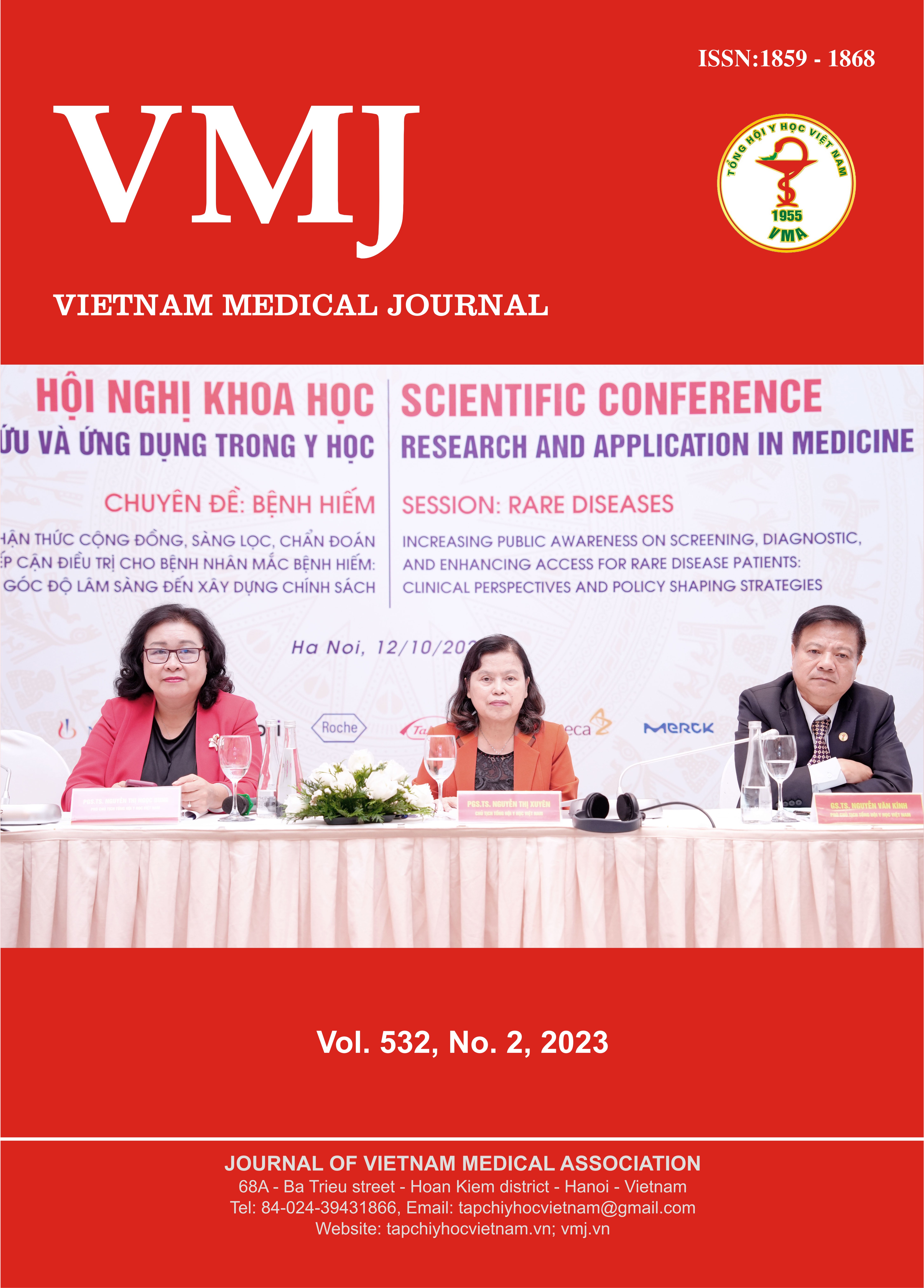THE EXPRESSION OF SFRP5 ON ADIPOSE TISSUES AND ITS ASSOCIATION WITH METABOLIC DISORDERS: A SYSTEMATIC REVIEW
Nội dung chính của bài viết
Tóm tắt
Objectives: This study aims to provide a comprehensive overview of the expression of Secreted Frizzled-related Protein 5 (Sfrp5) in adipose tissues and its association with metabolic disorders. Subjects and Methods: A systematic review was conducted. PRISMA guidelines and PICOT standards were used in this study. We searched the data using two search databases (PubMed and ScienceDirect). Results: Based on two databases, we identified 1853 potentially relevant articles. 10 documents that met all selection criteria were selected. Most articles showed that the expression of Sfrp5 increased in adipose tissues of mice fed a high-fat diet (HFD) for 8 weeks (n=1), at 16 weeks of mouse age (n=1), and in obese people (n=1). In addition, Sfrp5 was reported to have the higher expression in the DBA/2J strain (n=1), in the epididymal adipose tissue (n=1), in NASH patients (n=1), and in the presence of PPARγ (n=1). In contrast, some studies have shown that the expression of Sfrp5 has decreased significantly in the adipose tissue when B6 mice when ingested HFD for 12 weeks (n=1), at 16-31 weeks of mouse age (n=1), and in leptin-deficient mice when eating an HFD until 21-day-year old (n=1). However, a study had shown that the expression of Sfrp5 decreased when fat accumulation reached a stable level. This study seems to open up an explanation for the inconsistent evidence. These results have highlighted that Sfrp5 expression strongly correlates with obesity; thus, potential application directions have been shown in treating and preventing obesity (n=4). At the same time, the application potential of sfrp5 in cardiovascular diseases and fatty liver has also been proposed. Conclusion: Sfrp5 is a newly discovered protein in terms of function, so the evidence for Sfrp5 expression on adipose tissue has many gaps to exploit. Further studies, especially nutritional interventions, need to be carried out to elucidate its potential application to metabolic disorders.
Chi tiết bài viết
Từ khóa
Sfrp5; expression; adipocytes; adipose tissues; metabolic disorders.
Tài liệu tham khảo
2. Rani V, Deep G, Singh RK, Palle K, Yadav UC. Oxidative stress and metabolic disorders: Pathogenesis and therapeutic strategies. Life Sci. Mar 1 2016;148:183-93. doi:10.1016/j.lfs.2016.02.002
3. WHO. Global Health Observatory (GHO) data: Obesity. Accessed 07/03/2023, http://www.who.int/gho/ncd/risk_factors/obesity_text/en/
4. Ouchi N, Higuchi A, Ohashi K, et al. Sfrp5 is an anti-inflammatory adipokine that modulates metabolic dysfunction in obesity. Science. 2010;329(5990):454-457. doi:10.1126/science.1188280
5. Jura M, Jarosławska J, Chu DT, Kozak LP. Mest and Sfrp5 are biomarkers for healthy adipose tissue. Biochimie. 2016/05/01/ 2016;124:124-133. doi:https://doi.org/10.1016/j.biochi.2015.05.006
6. Zeng J, Hu J, Lian Y, Jiang Y, Chen B. SFRP5 is a target gene transcriptionally regulated by PPARγ in 3T3-L1 adipocytes. Gene. Jan 30 2018;641:190-195. doi:10.1016/j.gene.2017.10.066
7. Anunciado-Koza RP, Higgins DC, Koza RA. Adipose tissue Mest and Sfrp5 are concomitant with variations of adiposity among inbred mouse strains fed a non-obesogenic diet. Biochimie. 2016/05/01/ 2016;124:134-140. doi:https://doi.org/10.1016/j.biochi.2015.05.007
8. He X, Ma H. Correlation Between Circulating Levels of Secreted Frizzled-Related Protein 5 and Type 2 Diabetic Patients and Subjects with Impaired-Glucose Regulation. Diabetes Metab Syndr Obes. 2020;13:1243-1250. doi:10.2147/DMSO.S242657
9. Zhu Z, Yin S, Wu K, et al. Downregulation of Sfrp5 in insulin resistant rats promotes macrophage-mediated pulmonary inflammation through activation of Wnt5a/JNK1 signaling. Biochemical and Biophysical Research Communications. 2018/10/28/ 2018;505(2):498-504. doi:https://doi.org/10.1016/j.bbrc.2018.09.070
10. Zhao A, Jiang F, Yang G, Liu H, Li L. Sfrp5 interacts with Slurp1 to regulate the accumulation of triglycerides in hepatocyte steatosis model. Biochemical and Biophysical Research Communications. 2019/04/30/ 2019;512(2):256-262. doi:https://doi.org/10.1016/j.bbrc.2019.03.035
11. Mori H, Prestwich TC, Reid MA, et al. Secreted frizzled-related protein 5 suppresses adipocyte mitochondrial metabolism through WNT inhibition. J Clin Invest. Jul 2012;122(7):2405-16. doi:10.1172/JCI63604
12. Chu DT, Malinowska E, Jura M, Kozak LP. C57BL/6J mice as a polygenic developmental model of diet-induced obesity. Physiol Rep. Apr 2017;5(7)doi:10.14814/phy2.13093
13. Schulte DM, Muller N, Neumann K, et al. Pro-inflammatory wnt5a and anti-inflammatory sFRP5 are differentially regulated by nutritional factors in obese human subjects. PLoS One. 2012;7(2):e32437. doi:10.1371/journal.pone.0032437
14. Brandes J, Zobel I, Rohmann N, et al. Dipeptidylpeptidase (DPP)-4 inhibitor therapy increases circulating levels of anti-inflammatory soluble frizzle receptor protein (sFRP)-5 which is decreased in severe COVID-19 disease. Scientific Reports. 2022/09/02 2022;12(1):14935. doi:10.1038/s41598-022-18354-x
15. Nakamura K, Sano S, Fuster JJ, et al. Secreted Frizzled-related Protein 5 Diminishes Cardiac Inflammation and Protects the Heart from Ischemia/Reperfusion Injury. J Biol Chem. Feb 5 2016;291(6):2566-75. doi:10.1074/jbc.M115.693937
16. Bertran L, Portillo-Carrasquer M, Barrientos-Riosalido A, et al. Increased Secreted Frizzled-Related Protein 5 mRNA Expression in the Adipose Tissue of Women with Nonalcoholic Fatty Liver Disease Associated with Obesity. International Journal of Molecular Sciences. 2022;23(17). doi:10.3390/ijms23179871
17. Catalan V, Gomez-Ambrosi J, Rodriguez A, et al. Activation of noncanonical Wnt signaling through WNT5A in visceral adipose tissue of obese subjects is related to inflammation. J Clin Endocrinol Metab. Aug 2014;99(8):E1407-17. doi:10.1210/jc.2014-1191
18. Wang D, Zhang Y, Shen C. Research update on the association between SFRP5, an anti-inflammatory adipokine, with obesity, type 2 diabetes mellitus and coronary heart disease. J Cell Mol Med. Mar 2020;24(5):2730-2735. doi:10.1111/jcmm.15023
19. Li Y, Tian M, Yang M, et al. Central Sfrp5 regulates hepatic glucose flux and VLDL-triglyceride secretion. Metabolism - Clinical and Experimental. 2020;103doi:10.1016/j.metabol.2019.154029
20. Gutiérrez-Vidal R, Vega-Badillo J, Reyes-Fermín LM, et al. SFRP5 hepatic expression is associated with non-alcoholic liver disease in morbidly obese women. Annals of Hepatology. 2015/09/01/ 2015;14(5):666-674. doi:https://doi.org/10.1016/S1665-2681(19)30761-6
21. Hu W, Li L, Yang M, et al. Circulating Sfrp5 Is a Signature of Obesity-Related Metabolic Disorders and Is Regulated by Glucose and Liraglutide in Humans. The Journal of Clinical Endocrinology & Metabolism. 2013;98(1):290-298. doi:10.1210/jc.2012-2466


